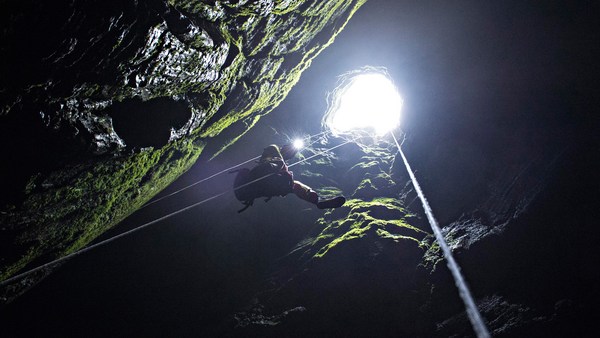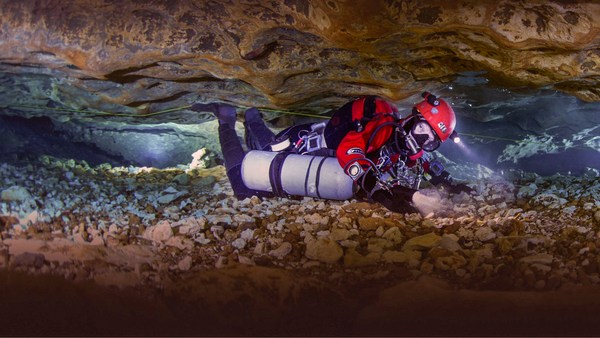So how many of you have ever been in a cave before? Okay, a few of you. When you think of a cave, most of you think of a tunnel going through solid rock, and in fact, that's how most caves are. Around this half of the country, most of your caves are made of limestone. Back where I'm from, most of our caves are made of lava rock, because we have a lot of volcanoes out there. But the caves I want to share with you today are made completely of ice, specifically glacier ice that's formed in the side of the tallest mountain in the state of Oregon, called Mount Hood.
Now Mount Hood's only one hour's drive from Portland, the largest city in Oregon, where over two million people live. Now the most exciting thing for a cave explorer is to find a new cave and be the first human to ever go into it. The second most exciting thing for a cave explorer is to be the first one to make a map of a cave. Now these days, with so many people hiking around, it's pretty hard to find a new cave, so you can imagine how excited we were to find three new caves within sight of Oregon's largest city and realize that they had never been explored or mapped before. It was kind of like being an astronaut, because we were getting to see things and go places that no one had ever seen or gone to before.
So what is a glacier? Well, those of you who have ever seen or touched snow, you know that it's really light, because it's just a bunch of tiny ice crystals clumped together, and it's mostly air. If you squish a handful of snow to make a snowball, it gets really small, hard and dense. Well, on a mountain like Hood, where it snows over 20 feet a year, it crushes the air out of it and gradually forms it into hard blue ice. Now each year, more and more ice stacks up on top of it, and eventually it gets so heavy that it starts to slide down the mountain under its own weight, forming a slow-moving river of ice. When ice packed like that starts to move, we call it a glacier, and we give it a name. The name of the glacier these caves are formed in is the Sandy Glacier. Now each year, as new snow lands on the glacier, it melts in the summer sun, and it forms little rivers of water on the flow along the ice, and they start to melt and bore their way down through the glacier, forming big networks of caves, sometimes going all the way down to the underlying bedrock. Now the crazy thing about glacier caves is that each year, new tunnels form. Different waterfalls pop up or move around from place to place inside the cave. Warm water from the top of the ice is boring its way down, and warm air from below the mountain actually rises up, gets into the cave, and melts the ceilings back taller and taller. But the weirdest thing about glacier caves is that the entire cave is moving, because it's formed inside a block of ice the size of a small city that's slowly sliding down the mountain.
Now this is Brent McGregor, my cave exploration partner. He and I have both been exploring caves a long time and we've been climbing mountains a long time, but neither one of us had ever really explored a glacier cave before. Back in 2011, Brent saw a YouTube video of a couple of hikers that stumbled across the entrance to one of these caves. There were no GPS coordinates for it, and all we knew was that it was somewhere out on the Sandy Glacier. So in July of that year, we went out on the glacier, and we found a big crack in the ice. We had to build snow and ice anchors so that we could tie off ropes and rappel down into the hole. This is me looking into the entrance crevasse. At the end of this hole, we found a huge tunnel going right up the mountain underneath thousands of tons of glacier ice. We followed this cave back for about a half mile until it came to an end, and then with the help of our survey tools we made a three-dimensional map of the cave on our way back out.
So how do you map a cave? Well, cave maps aren't like trail maps or road maps because they have pits and holes going to overlapping levels. To make a cave map, you have to set up survey stations every few feet inside the cave, and you use a laser to measure the distance between those stations. Then you use a compass and an inclinometer to measure the direction the cave is headed and measure the slope of the floor and the ceilings. Now those of you taking trigonometry, that particular type of math is very useful for making maps like this because it allows you to measure heights and distances without actually having to go there. In fact, the more I mapped and studied caves, the more useful I found all that math that I originally hated in school to be. So when you're done surveying, you take all this data and you punch it into a computer and you find someone that can draw really well, and you have them draft up a map that looks something like this, and it'll show you both a bird's-eye view of the passage as well as a profile view of the passage, kind of like an ant farm view. We named this cave Snow Dragon Cave because it was like a big dragon sleeping under the snow. Now later this summer, as more snow melted off the glacier, we found more caves, and we realized they were all connected.
Not long after we mapped Snow Dragon, Brent discovered this new cave not very far away. The inside of it was coated with ice, so we had to wear big spikes on our feet called crampons so we could walk around without slipping. This cave was amazing. The ice in the ceiling was glowing blue anad green because the sunlight from far above was shining through the ice and lighting it all up. And we couldn't understand why this cave was so much colder than Snow Dragon until we got to the end and we found out why. There was a huge pit or shaft called a moulin going 130 feet straight up to the surface of the glacier. Cold air from the top of the mountain was flowing down this hole and blasting through the cave, freezing everything inside of it. And we were so excited about finding this new pit, we actually came back in January the following year so we could be the first ones to explore it. It was so cold outside, we actually had to sleep inside the cave. There's our camp on the left side of this entrance room. The next morning, we climbed out of the cave and hiked all the way to the top of the glacier, where we finally rigged and rappelled this pit for the very first time. Brent named this cave Pure Imagination, I think because the beautiful sights we saw in there were beyond what we could have ever imagined.
So besides really cool ice, what else is inside these caves? Well not too much lives in them because they're so cold and the entrance is actually covered up with snow for about eight months of the year. But there are some really cool things in there. There's weird bacteria living in the water that actually eat and digest rocks to make their own food to live under this ice. In fact, this past summer, scientists collected samples of water and ice specifically to see if things called extremophiles, tiny lifeforms that are evolved to live in completely hostile conditions, might be living under the ice, kind of like what they hope to find on the polar icecaps of Mars someday. Another really cool things is that, as seeds and birds land on the surface of the glacier and die, they get buried in the snow and gradually become part of the glacier, sinking deeper and deeper into the ice. As these caves form and melt their way up into the ice, they make these artifacts rain down from the ceiling and fall onto the cave floor, where we end up finding them. For example, this is a noble fir seed we found. It's been frozen in the ice for over 100 years, and it's just now starting to sprout. This mallard duck feather was found over 1,800 feet in the back of Snow Dragon Cave. This duck died on the surface of the glacier long, long ago, and its feathers have finally made it down through over 100 feet of ice before falling inside the cave. And this beautiful quartz crystal was also found in the back of Snow Dragon.
Even now, Brent and I find it hard to believe that all these discoveries were essentially in our own backyard, hidden away, just waiting to be found. Like I said earlier, the idea of discovering in this busy world we live in kind of seems like something you can only do with space travel now, but that's not true. Every year, new caves get discovered that no one has ever been in before. So it's actually not too late for one of you to become a discoverer yourself. You just have to be willing to look and go where people don't often go and focus your eyes and your mind to recognize the discovery when you see it, because it might be in your own backyard.
Thank you very much.
(Applause)





